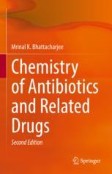Search
Search Results
-
Antibiotics That Inhibit Nucleic Acid Synthesis
Antibiotics that inhibit the synthesis of nucleic acids including DNA and RNA are presented. Background biochemistry information on the structure of...
-
Antibiotics That Inhibit Protein Synthesis
Antibiotics that inhibit protein synthesis are discussed. Background biochemistry information on translation is provided. Antibiotics presented...
-
RNA: Information and Function Carrier
In molecular biology dogma, ribonucleic acid (RNA) is the mediator between the information carrier DNA and the functional carrier protein. RNA is...
-
Drug Development
The development of a new drug is lengthy, risky, and therefore expensive. According to studies by the management consultancy firms...
-
Introduction
Chemical biology is not a new science, although the term was only formulated in the 1990s. The first chemical biology experiments in which chemical...
-
Peptides and Proteins
Peptides and proteins are functional biopolymers composed of 20 natural alpha-L-amino acids in varying order (sequence). Peptides are divided into...
-
Chemical Proteomics: From Chemical Probe to Target Protein
Affinity chromatography plays a central role in chemical proteomics. As shown in Fig. 14.1, the chemical probe to be investigated is immobilized on a...
-
Gene Therapy and Genome Editing
In recent years, scientific successes have increasingly brought to the fore the possibilities of modifying genes and the genome as a therapeutic...
-
Global Action Plan and Antibiotic Stewardship
The World Health Organization has adopted a Global Action Plan to tackle antimicrobial resistance and to meet the goals of the plan, all member...
-
Antifungals, Antimalarials, and Antivirals
This chapter includes a discussion of antifungal, antimalarial, and antiviral drugs. Similarities and differences of these with antibacterial...
-
Antimetabolites: Antibiotics That Inhibit Nucleotide Synthesis
Antimetabolites as antibiotics that inhibit the synthesis of nucleotides needed for nucleic acid synthesis. Background biochemistry on folic acid...
-
Antibiotics That Affect the Membrane and Other Structural Targets
Antibiotics as well as antiseptics and disinfectants that affect the bacterial cell membrane and other structural targets are discussed. Background...
-
Chemical Biology: A Holistic Science
Chemical biology is the science that uses chemical substances, usually synthetically produced, to understand and manipulate complex biological...
-
From Target Protein to Biologics
Opposite to the low-molecular active agent with its advantages and disadvantages stands the macromolecular active agent. While low molecular chemical...
-
Chemical Genomics: From Target Protein to Small Molecule Drug
In forward chemical genomics, agents are tested on cells to induce a biological change (phenotype). The target of the drug is then determined. In...
-
Conclusion and Perspectives
Production of enantiopure mechanically planar chiral rotaxanes was successfully achieved by using the chiral 4-pyrrolidinopyridine (PPY) catalysts....
-
Divalent Lanthanide Luminescence in Solution
The objective of this chapter is to function as a tutorial for those who are new to the field of divalent lanthanide luminescence and as a resource...
-
Circularly Polarized Emission of Lanthanide Ion Complexes
A research field, where Ln3+ ions dominate the scene for their unique properties is the emission of circularly polarized light primarily under...
-
Lanthanide Emission for Solar Spectral Converters: An Energy Transfer Viewpoint
The role of the energy transfer mechanisms behind the efficient emission of lanthanide-based complexes will be discussed. Emphasis will be given to...
-
Visible Emitting Lanthanide Ions in Bioimaging
Lanthanide cation, once incorporated with a ligand, provides a complex for which luminescence can be observed. The stability of the complex and its...
